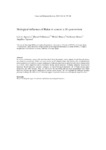Biological influence of Hakai in cancer: a 10-year review

Ver/
Use este enlace para citar
http://hdl.handle.net/2183/19549Coleccións
- INIBIC-OCT - Artigos [21]
Metadatos
Mostrar o rexistro completo do ítemTítulo
Biological influence of Hakai in cancer: a 10-year reviewAutor(es)
Data
2012-02-19Cita bibliográfica
Aparicio LA, Valladares M, Blanco M, Alonso G, Figueroa A. Biological influence of Hakai in cancer: a 10-year review. Cancer Metastasis Rev. 2012;31(1-2):375-386
Resumo
[Abstract] In order to metastasize, cancer cells must first detach from the primary tumor, migrate, invade through tissues, and attach to a second site. Hakai was discovered as an E3 ubiquitin-ligase that mediates the posttranslational downregulation of E-cadherin, a major component of adherens junctions in epithelial cells that is characterized as a potent tumor suppressor and is modulated during various processes including epithelial–mesenchymal transition. Recent data have provided evidences for novel biological functional role of Hakai during tumor progression and other diseases. Here, we will review the knowledge that has been accumulated since Hakai discovery 10 years ago and its implication in human cancer disease. We will highlight the different signaling pathways leading to the influence on Hakai and suggest its potential usefulness as therapeutic target for cancer.
Palabras chave
Hakai
E3 ubiquitin-ligase
E-cadherin
Epithelial–mesenchymal transition
E3 ubiquitin-ligase
E-cadherin
Epithelial–mesenchymal transition
Versión do editor
Dereitos
The final publication is avaliable at Springer Link
ISSN
0167-7659
1573-7233
1573-7233





